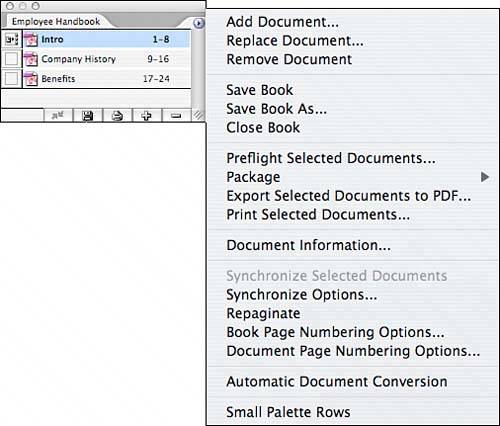EXPORTING TO PDF
| To export your document to a PDF file, select File, Export and choose Adobe PDF in the Format pop-up. Name your file and navigate to the spot where you want to save it. Click Save. A dialog opens with numerous export options, all of which you explore in the next section. If you work with several small documents that make up a larger whole, you can join those documents together by creating a book, as described in Chapter 25, "Understanding Document and Page Setup in InDesign." Then, you can export either the entire book or just selected book documents by selecting the Export to PDF option from the Book palette menu (see Figure 31.1). Figure 31.1. Export PDFs from the Book palette to create a PDF that contains all documents in the book.
PDF SettingsAfter you name your PDF and choose its location, you have quite a few options for exporting your PDF. Again, these options are very important if you will be printing your document with a commercial printer because the settings you choose have to fit into the workflow of your service bureau and/or printer.
PDF/X-1a:2001 and PDF/X-3:2002 are also available presets. These settings refer to specific standards for graphic compliance. Check out Part V, "Acrobat, Distiller, and Designer," later in this book for more detailed information. One place to start with your PDF settings is by choosing a PDF Preset. InDesign is preloaded with several PDF presets, including High Quality Print, Press Quality, and Smallest File Size. Based on where and how your document will be read and output, choosing one of these options might be a good starting point for creating your PDF. The text in the Description box gives you a good idea of the best use for each setting (see Figure 31.2). Figure 31.2. You can choose from various PDF presetsthey are often a good starting point for document export.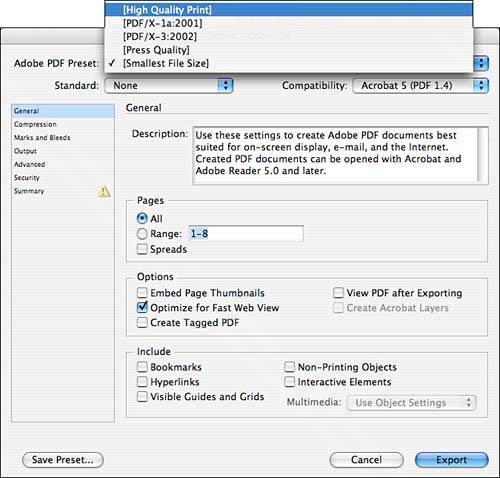 The Standard pop-up menu should stay at None unless you are working to specific PDF/X-1a:2001, PDF/X-1a:2003, PDF/X-3:2002 and PDF/X-3:2003 standards for color-managed documents. In the Compatibility pop-up menu, choose the version of Acrobat to which your document should conform, from version 4 through version 7. Especially if you are exporting the document for viewing only, you should work to the lowest version that your audience may have. Lower versions of Acrobat do not support some features of InDesign documents, such as transparency. The Adobe Help Center contains a great chart, titled PDF Compatibility Levels, which details the features supported by various versions. The Export Adobe PDF dialog has seven categories of options. When you select a category from the pane on the left, the options on the right change to reflect the selected category. The following sections describe the options in each of the categories in this dialog. General OptionsIn the Pages area, choose All or enter a range of pages. If you prefer to export your document in spreads (left and right facing pages) as opposed to single pages, click the Spreads check box. The Options area of the General page contains various settings:
The Include area contains options that can help with the navigation and view of your document. You can include Bookmarks, specified in the Bookmarks palette, for table of content entries; Hyperlinks, which are clickable links created by hyperlinks, table of contents, and index entries; Visible Guides and Grids, which show all guides and grids visible on the InDesign page; Non-Printing Objects, which are items you've specified as nonprinting in the Attributes palette; and Interactive Elements, or all movies, sounds, and buttons embedded in the document. The Multi-media pop-up menu becomes active when you work with Acrobat 6 or higher documents because you can choose either to link or embed interactive items in the document. For Acrobat 4 and 5, you must embed sounds and link movies, which doesn't give you a choice in this area. Compression OptionsThe Compression panel of the Export Adobe PDF dialog enables you to select how to deal with color, grayscale, and monochrome images (see Figure 31.3). If you are creating documents for viewing onscreen or on the web only, it's a good idea to choose a downsampling option for the different types of images, because it's going to result in smaller file sizes without causing the images to lose visual quality. If you are printing these documents, however, this is an important place to check with your service provider liaison and get advice on how he or she would suggest you prepare the document. Figure 31.3. PDF Compression options.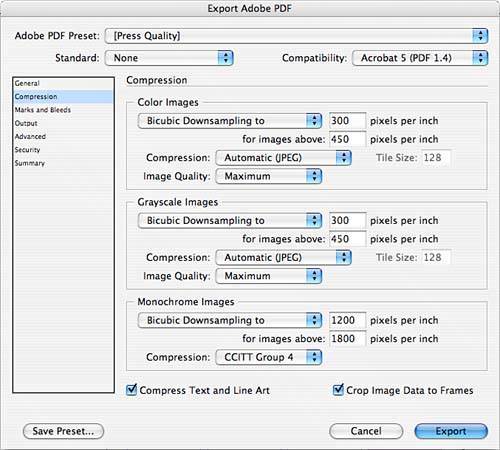 Without going into too much detail about each individual setting (that comes later in this chapter), let's take a look at what the various options mean. In the Color Images area of the panel, the pop-up menu that refers to downsampling determines how pixels within the images are deleted and blended with neighboring pixels to create a smooth display. Choosing Subsampling results in smaller images files and smaller documents. Choosing Bicubic Downsampling results in smooth, high-quality images but larger document sizes. The Compression pop-up menu gives you options that help make your images smaller and faster to load. Automatic (JPEG) gives you the highest quality. The Image Quality pop-up menu refers to how much compression you apply. Minimum gives you smaller images with less quality; Maximum gives you better quality but larger images. The Tile Size option is available for files compatible with Acrobat 6 and higher and set with JPEG 2000 compression. It enables you to choose the size of tiles when you load images with progressive displaythink of this as how images load in web pages, one part at a time. The Compress Text and Line Art check box at the bottom of the dialog applies compression to those items without loss of quality. The Crop Image Data to Frames option, also at the bottom of the dialog, deletes any extra image information that falls outside the frame in which it's displayed and reduces file size. Marks and Bleeds OptionsBased on your choices in the check boxes in the Marks and Bleeds panel of the Export Adobe PDF dialog (see Figure 31.4), various printer's marks are applied to your page. Again, you may want to check with your printer to see whether any of these marks are required. You would not want to select any options in this panel if you are creating a PDF for the web or onscreen viewing only. Figure 31.4. PDF Marks and Bleed options.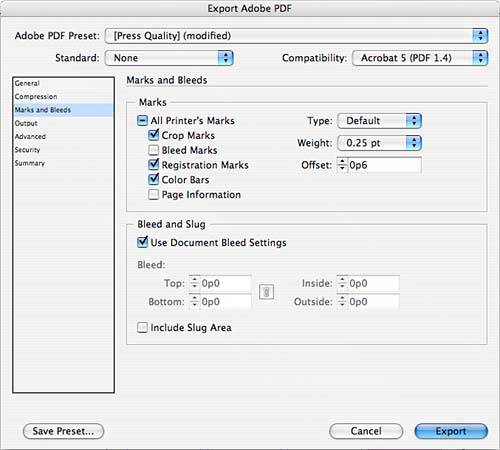 If objects bleed off your page or extend all the way to the page edge, you have two chances to set up a bleed area. The first is when you create your document in the Document Setup dialog. If you set up your bleed there, click the Use Document Bleed Settings check box on the Export Adobe PDF dialog. If not, you can specify your bleed area here. Setting up a bleed area is just a safety net for bleeds; you can make them extend past the crop marks to ensure you don't have a white line between your image and the edge of your page. If you set up a slug area to provide printing or output instructions, enable the Include Slug Area check box. Output OptionsThe Options panel of the Export Adobe PDF dialog gives you options for handling color management within your document (see Figure 31.5). Choices vary depending on whether you have color management turned on for the document, whether you have applied a color profile to the document, and which PDF standard has been selected. To get more information about the individual settings, hold your mouse over the selection and a brief explanation will appear in the Description field. There is also an explanation of PDF color later in this chapter. Figure 31.5. PDF Output options.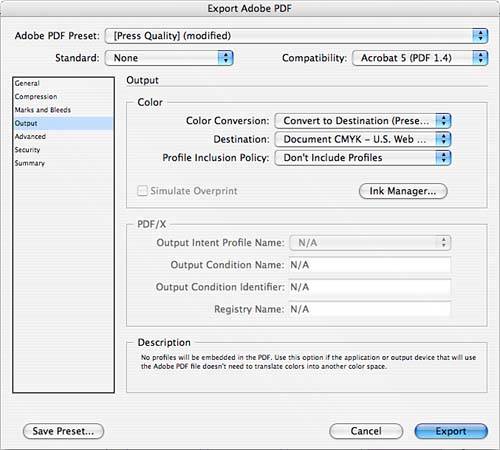 Advanced OptionsThe Font section of the Advanced panel of the Export Adobe PDF dialog enables you to choose at what point the font should be embedded in the document (see Figure 31.6). Say you enter 75% in the field. If less than 75% of the individual characters in that font are used in the document, the font will be a subset, or only those characters used are included in the document. If 75% of the characters or more are used, the entire font will be embedded, which increases your file size. Figure 31.6. Advanced PDF options.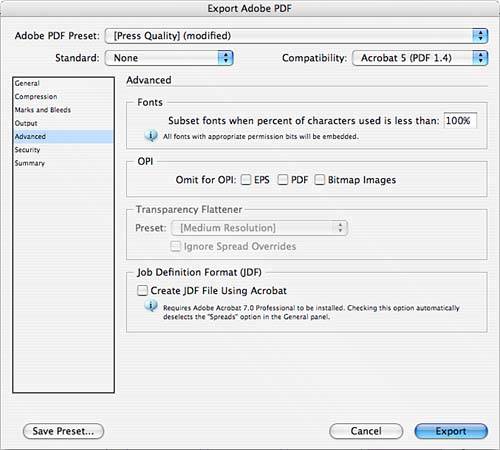 The Omit for OPI option enables you to select various graphic types used in your document that can be omitted, making a smaller file. A low-resolution version of the graphic will be used for display only, and the high-resolution graphic will be swapped in when the file is output. You must send the high-resolution graphic with your file so it can be included with output. If a graphic is embedded, this choice will not apply to it. If you select an export version of Acrobat 5 or higher in the Compatibility pop-up menu, the Transparency Flattener option is not available because transparency is automatically supported and preserved in documents in later PDF versions (see Figure 31.7). You can choose High, Medium, or Low Resolution options that apply to all pages in the document with transparency applied. A complete explanation of transparency flattening is found later in this chapter. Figure 31.7. Transparency Flattening options for your PDF. If you have set up in your document to apply a flattening preset on certain spreads, you can click the Ignore Spread Overrides check box to maintain the choice you make in this panel throughout the document. If you have Acrobat 7 installed, the Advanced panel also gives you an option to create a JDF, (Job Definition Format) file that will travel with your document. The JDF contains file references and instructions for prepress creation. Security OptionsSecurity options are available only for files exported for Acrobat 5 and higher (see Figure 31.8). Figure 31.8. Security options for your PDF.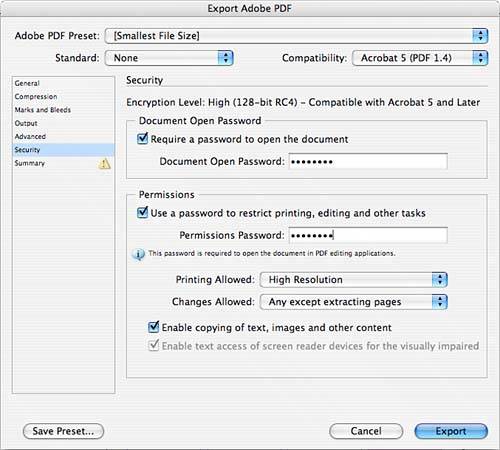 If you want to require users to enter a password when they try to open the file, click in the Document Open Password check box and enter the password you want them to use. In the Permissions area, you can set up various degrees of protection for your document. Click in the first check box to restrict printing, editing, and other document changes, and enter a password. Then choose whether to allow high-resolution, low-resolution, or no printing, and whether to allow various page and form tasks. You can also check the box to enable page elements to be copied. With high security settings, you also have the option to allow users to access the document with software that reads the document for the visually impaired. Summary OptionsThe final panel of the PDF Export dialog is a summary (see Figure 31.9). You can drill down through the various PDF settings to see the choices that were made for this document. This is especially useful if you are using a PDF preset and want to access information about the document quickly. Click Save Summary to save a text file of this information. Figure 31.9. The PDF Summary panel.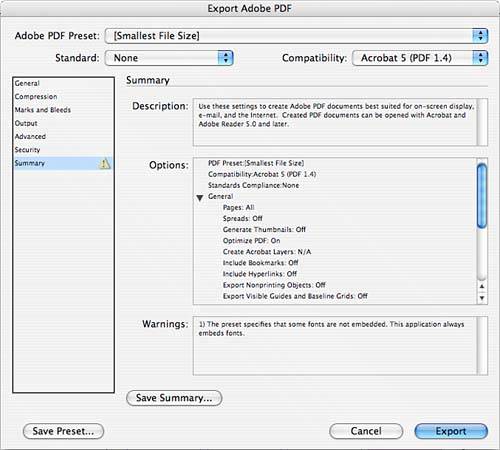 Before you click the Export button, notice the Save Preset button in the lower left of the dialog. If you are creating multiple documents with the same settings or will always have to export with the same options for a specific printer, you can save these settings and quickly load them for use with various documents. Click the Save Preset button, name the preset, and click OK. From that point on, the preset you saved will be available if you go to File, Adobe PDF Presets, [preset name]. After you load your preset, you can click Export and know that everything is being saved exactly as you set it up. |
EAN: 2147483647
Pages: 426
